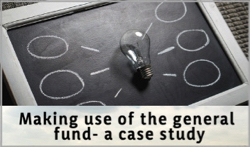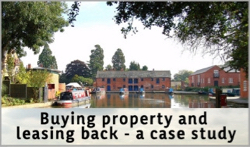Case studies
Making a loanback from a SSAS
A SSAS can loan 50% of its value to a connected company
Case Study 1
EP Ltd is a well-established, profitable business that supplies specialist parts to new vehicle manufacturers. In 2015 it experienced a sharp and unexpected decline in turnover. The business needed additional funding to help tide it over until trade improved. The business was already fully utilising its maximum invoice discount facility. The business assets were principally debtors, with plant and machinery. The bank were prepared to offer an overdraft facility, however, they required personal guarantees and second charges from the directors, which they were very uncomfortable with. Whilst the plant and machinery was of great value to the business, it was viewed more akin to scrap metal by the bank, hence the requirement for personal security.
The directors had faith in the long-term viability of the business. They had built up pension funds over the years and decided to mobilise their funds by way of self-investment into the business. A Small Self Administered Scheme (SSAS) was set up with SSAS Practitioner.com and utilised to make a £250,000 loan to EP Ltd. The loan was a five-year term loan, secured by a first charge over a very large and important item of plant, which was professionally and independently valued. The Invoice Discount Provider agreed to release the plant from their debenture, as they would have a first call over the debtors, which was their principal interest. EP Ltd received the cash and made monthly loan repayments to the pension fund, as opposed to the bank. No personal guarantees were required. The cash took the pressure off, providing much needed operating capital, and allowed the directors to focus primarily on managing the business.
By mid 2018 the company was again trading profitably, due in part to diligent management and cost control. The pension loanback had been paid down to £98,000 and the SSAS benefited from the guaranteed returns from the loan repayments. The older members of the SSAS had not been restricted in terms of taking tax-free cash or income, as plenty of liquidity remained available in the SSAS. The company has a very healthy outlook and is currently considering purchasing the freehold of the commercial site it operates from. The directors are in talks with the financial adviser regarding how the SSAS could assist.
Case Study 2
NSS Ltd is heavily involved in the green energy industry, working flat out to meet demand, going from a five-figure turnover to a seven-figure one within a year. One of the directors has invented, and registered a patent for, a device to financially optimise the green energy source for the benefit of the householder. The device is attracting a great deal of interest from other companies, worldwide, who wish to be involved in the massive potential of the device.
Once again, NSS Ltd is short of operating capital as their profits are tied up in stock and work in progress. A cash injection of £50,000 would give much-needed breathing space, and allow the directors to focus on the marketing and distribution of their invention. It would ensure they were not pressured financially into accepting distribution terms form a third party that were not the best available.
The directors do not have a lot of equity in their houses and were struggling to obtain funding, even with a personal guarantee. They did, however, have some personal pensions they had contributed to. They had also contacted out of SERPS, and had personal pensions that the government had paid National Insurance rebates into.
A solution was found whereby the directors set up a new SSAS with SSAS Practitioner.com and transferred in their personal pension arrangements (having received appropriate financial advice). The SSAS made a five-year term loan to the company for £50,000. The SSAS took an all asset debenture over the company including the registered patent as a First fixed and floating charge. The directors were particularly pleased with the creditor-protected status of the SSAS, and the business.
The company continues to thrive, and the directors can focus on operating the business instead of chasing invoices. The SSAS provided funding where none was available, with the pension fund receiving the commercial profits of the borrowing instead of a third-party lender.
Advice should be sought from an Independent Financial Adviser before setting up a SSAS and making a loanback.
Case Study 3
Mr Turner has a long-established IT company and has also recently acquired a stake in a recruitment firm.
Mr Turner is concerned at the 12% interest rate being charged by a commercial lender to the recruitment firm, which was used to finance the purchase of office equipment and to provide ongoing working capital. There are five years left on the loan.
The concerns of Mr Turner are discussed with his IFA who suggests setting up a SSAS for it to replace the commercial borrowing. As the recruitment firm has only been trading for a number of months it is unsuitable to sponsor a SSAS, but the established IT company can fulfil this function.
Mr Turner makes enquiries into transferring in an old final salary scheme he has from his employed days into the SSAS. As the value of this plan is over £30,000 and it is a final salary scheme he discovers that this cannot be transferred without regulated advice being provided. His IFA is not qualified to provide this; however, the IFA puts Mr Turner in touch with a colleague who can and the transfer proceeds.
Once the IT company-sponsored SSAS has been established the recruitment firm is brought into the scheme as a Participating Employer so that it can borrow from the scheme. The SSAS then forwards this loan.
The transfer value was £160,000 and the amount of company borrowing to be replaced was £100,000. As the maximum loan allowed from a SSAS is 50% of SSAS value, the IT company made a contribution of £40,000 to the SSAS. This boosted the SSAS value to accommodate the £100,000 loan.
The contribution was tax relievable for the company and therefore saved corporation tax at a rate of 19%. A highly efficient transaction as aside from the corporation tax mitigation, the amount transferred to the SSAS grows free of capital gains and income tax.
A loanback from a SSAS to a connected company must be on a secured basis. Therefore, on the same day, the loan was advanced to the recruitment firm, it repaid its borrowing from the commercial lender and the solicitor acting for the scheme removed the charge in favour of the lender and simultaneously took an all assets debenture on the company on behalf of the scheme.
Mr Turner is delighted that the company's obligations are reduced considerably, and that his pension scheme will now receive the interest payments for his benefit rather than for a third-party lender.





